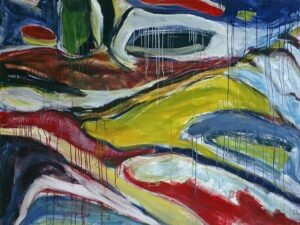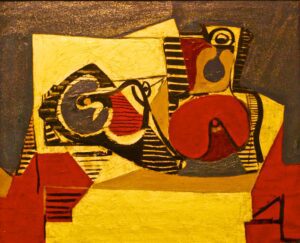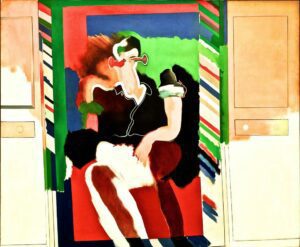Post-painterly abstraction marks a defining moment in modern art, stripping back the emotional intensity of Abstract Expressionism for a cooler, more refined aesthetic.
It’s an evolution that we’ll explore, highlighting its impact on the art world and how it reshaped our understanding of abstraction.
We’ll jump into the characteristics that set post-painterly abstraction apart, from its bold use of color to its emphasis on form and space.
Stay tuned as we uncover the artists who pioneered this movement and their lasting influence on contemporary art.
Characteristics Of Post-painterly Abstraction
Post-painterly abstraction represents a significant departure from the subjective, emotive energy of its Abstract Expressionist predecessors.
We observe an intellectual rigor in these works where emotion is downplayed in favor of a more detached, analytical approach.
This movement foregrounds clarity, openness, and purity of form.
Artists working within the post-painterly abstraction genre prioritize a visual language that emphasizes flatness and reduces the illusion of depth.
Their art is characterized by:
- Large-scale canvases,
- Bold simplicity of design,
- A visible emphasis on the physical properties of paint.
The use of solid colors is

Through careful modulation of tone and the application of expansive monochromatic fields, artists like Mark Rothko and Barnett Newman engage viewers in a contemplative visual experience.
These color fields serve not just an aesthetic purpose; they’re essential for conveying the sense of calm and order central to the movement.
Experimentation with form and space surfaces often in the works of post-painterly abstractionists.
Unlike the gestural brushwork of Abstract Expressionism, this movement championed the use of sharp-edged shapes, uniform application of color, and overall compositional balance.
Helen Frankenthaler’s soak-stain technique, for instance, created fluid forms that appeared to melt into unprimed canvas, further highlighting the intrinsic qualities of the medium.
It’s important to note that post-painterly abstraction does not represent a cohesive style but more of a collective approach toward objectivity in painting.
We see a deliberate move away from the mythic and highly personal symbolism of earlier abstract works, favoring instead a more impersonal and universally communicative aesthetic.
The harmonization of color, line, and surface in post-painterly abstract works is not only a hallmark of the movement but also a revolutionary stride in the evolution of modern art.
Bold Use Of Color In Post-painterly Abstraction
Artists within the post-painterly abstraction movement were renowned for their audacious use of color.
They employed hues in vast, flat fields to elicit an immediate sensory response rather than conveying the emotional depth commonly found in Abstract Expressionist works.
This strategic use of color helps to differentiate post-painterly abstraction as a distinct artistic approach, where chromatic intensity and simplicity reign supreme.
A notable aspect of this approach is the lack of gradation.
Pigments appear in their most vibrant and pure state, often positioned adjacent to other equally intense colors.
This creates stark contrasts and allows each element within the composition to stand independently.
In Blue Balls, for instance, Helen Frankenthaler uses a soaring blue that overwhelms the senses and immediately draws the eye to the brilliance of her color choices.
In leveraging color as a medium for expression, these artists align color with form, often uniting both to produce a cohesive and striking visual impact.
Examples of this can be seen in:
- Mark Rothko’s enveloping color fields,
- Ellsworth Kelly’s sharp delineation between colors,
- Frank Stella’s exuberant color palettes.
Through such bold use, color becomes a primary conveyor of meaning.
It’s not about what color can symbolize or represent, it’s about what color is in its purest form – a visual language in and of itself.
Each hue on the canvas is deliberate and calculated, crafted to captivate the viewer’s gaze and hold it within the bounds of the composition’s vivid tableau.
Emphasis On Form And Space In Post-painterly Abstraction
The shaping of form and the treatment of space in post-painterly abstraction bring a distinctive clarity to the art movement.
These artists embraced a simplification of form to its most fundamental elements.
Diluting narrative and representational cues, they focused on creating spatial relationships that resonate on an intuitive level.
Space in these compositions assumes an active role, as vital as the forms that inhabit it.
We see this in the vast expanses of color in Barnett Newman’s work, where the concept of ‘zips’ introduces stark, defining lines that carve the painting into virtual environments.
These elements aren’t mere occupants of space; they define and transform it.

Strategies characteristic of post-painterly abstraction art:
- Reduction of shapes to geometric essentials,
- Use of negative space to accentuate form,
- Creation of dynamic tension through spatial interaction.
Artists orchestrating form and space invite viewers to engage with artwork directly, seeking a visceral and meditative experience.
The canvases of Helen Frankenthaler, with their stained colors, turn space into a fluid medium, while Kenneth Noland’s targets and chevrons manipulate perception, creating movement and depth.
Our appreciation of these artworks grows as we understand the deliberate decisions artists made to emphasize the symbiosis of form and space.
Artists Who Pioneered Post-painterly Abstraction
When diving into the world of post-painterly abstraction, it’s crucial to acknowledge the artists who broke new ground.
Their contributions not only defined the movement but also charted the course for those who followed.
We’ll highlight key figures whose innovative approaches to painting helped to cement this movement in the annals of art history.
Clement Greenberg – not an artist himself but a prominent critic – played a significant role in shaping the post-painterly abstraction movement.
His keen insight and support provided the conceptual framework for what these artists endeavored to achieve.
Meanwhile, artists like Frank Stella and Ellsworth Kelly pushed the boundaries of what constituted a painting.
Their exploration of form, color, and composition was pivotal, introducing a visual language stripped of narrative and emotional content.
Stella’s Black Paintings and Kelly’s bold, flat color panels are enduring works that continue to inspire discussions about form over content in abstract art.
- Barnett Newman – known for his “zip” paintings,
- Helen Frankenthaler – innovator of the soak-stain technique,
- Kenneth Noland – famed for his target and chevron motifs,
- Jules Olitski – experimented with sprayed paint.
The work of these artists illustrates a departure from the gestural strokes of abstract expressionism.
Noland’s concentric circles and chevrons in works like Beginnings used the canvas as an arena for color and shape interactions.
Olitski’s technique of spraying paint allowed for a layering effect that further distanced the movement from its abstract expressionist roots.
It’s essential to understand the visual strategies these artists employed – strategies that elicit a unique, visceral response without the crutches of representation or narrative.
Our appreciation for their craft is distilled in their pursuit of artistic purity.
Each work rendered by these pioneers beckons viewers to consider the elemental aspects of painting – hue, form, and the spatial dynamics they create.
Through this lens, post-painterly abstraction can be seen as a natural progression in the evolution of modern art, laying the groundwork for the minimalist and conceptual artworks that followed.
Influence Of Post-painterly Abstraction On Contemporary Art
Post-painterly abstraction didn’t just redefine painting during its peak; it has significantly influenced contemporary artists and disciplines.
It’s hard to walk through a modern art exhibition without seeing the ripple effects of this movement.
The clear lines and bold colors continue to resonate, finding new meanings in the hands of today’s visionaries.
Artists today often draw upon the visual language established by post-painterly abstraction to inform their work.
It’s evident in the large-scale installations and minimalist sculptures seen around the world.
The legacy of post-painterly abstraction can also be found in mediums beyond traditional canvases, where artists use space and form to communicate complex themes.
The influence of post-painterly abstraction extends into:

- Multimedia art projects – Public space interventions – Digital art platforms.
Our experience of digital media and filmmaking, for instance, reflects the movement’s emphasis on simplicity and focus.
Filmmakers have adopted similar principles to create visuals that capture the essence of a story without unnecessary complexity.
In video art, the patterns and rhythms developed by post-painterly artists have been translated into time-based narratives, creating an immersive viewer experience.
In the realm of graphic design and advertising, the movement’s principles have been foundational.
Designs characterized by bold simplicity and strategic use of space are not merely visual tactics but also powerful tools for communication.
This has led to a certain timelessness in advertising campaigns and branding strategies, proof that post-painterly abstraction’s influence is as practical as it is profound.
Today’s creative talents harness the same fascination for purity and clarity of expression that drove the pioneers of post-painterly abstraction.

Whether in the texture of a digital animation or the structure of an Indie Film’s storytelling, the spirit of the movement is unmistakable.
The boundaries of this abstract language continue to be pushed, ensuring the evolution of visual culture remains vibrant and diverse.
What Is Post Painterly Abstraction In Art – Wrap Up
We’ve seen how post-painterly abstraction revolutionized the art world, steering creativity towards a new horizon of form and space.
It’s clear that the movement’s legacy endures, influencing a broad spectrum of contemporary art forms.
As we continue to explore and appreciate the nuances of this pivotal movement, we’re reminded of the enduring power of art to evolve and resonate.
The visionaries behind post-painterly abstraction have left an indelible mark, shaping the way we perceive and interact with visual culture.
Their commitment to purity and clarity of expression remains a guiding force for artists today, ensuring that the spirit of innovation in art is as alive now as it was decades ago.
Frequently Asked Questions
What Is Post-painterly Abstraction?
Post-painterly abstraction refers to a style of painting that emerged in the late 1950s and early 1960s, emphasizing a more rigorous approach to abstraction that focused on form and space, moving away from the emotional brushwork of abstract expressionism.
Who Are Key Figures In Post-painterly Abstraction?
Clement Greenberg, Frank Stella, Ellsworth Kelly, Barnett Newman, Helen Frankenthaler, Kenneth Noland, and Jules Olitski are among the key figures who pioneered the post-painterly abstraction movement.
How Does Post-painterly Abstraction Differ From Abstract Expressionism?
Post-painterly abstraction differs from abstract expressionism in its lack of gestural brushstrokes and emotional intensity.
It favors clean lines, simple shapes, and color fields to evoke a purely visual response.
What Impact Did Post-painterly Abstraction Have On Contemporary Art?
Post-painterly abstraction influenced contemporary art by informing multimedia art projects, interventions in public spaces, and digital art platforms.
It also affected other mediums such as film, video art, graphic design, and advertising.
Do Contemporary Artists Still Draw On Post-painterly Abstraction Principles?
Yes, contemporary artists continue to be inspired by the principles of post-painterly abstraction, harnessing its emphasis on purity and clarity of expression in the ongoing evolution of visual culture.


